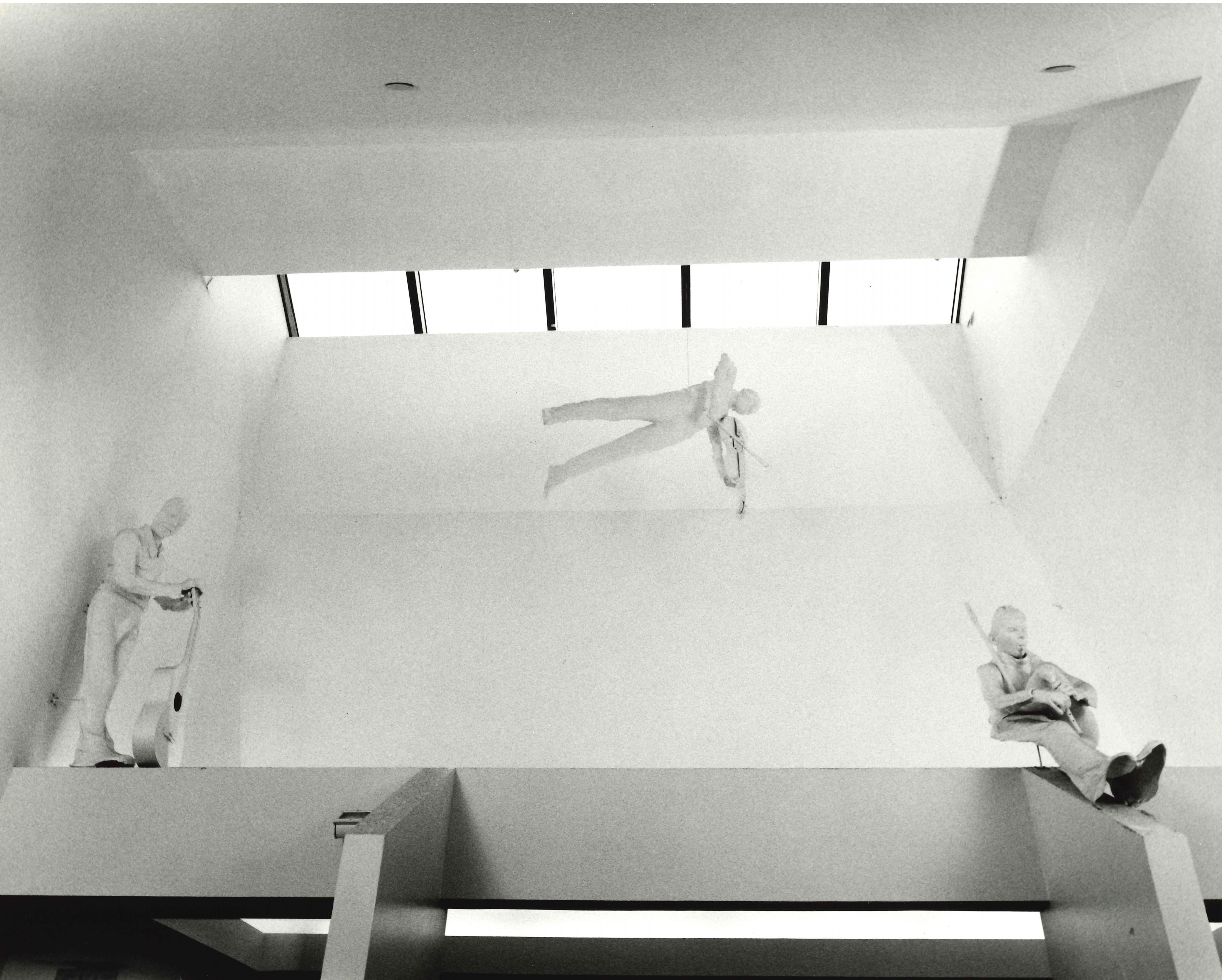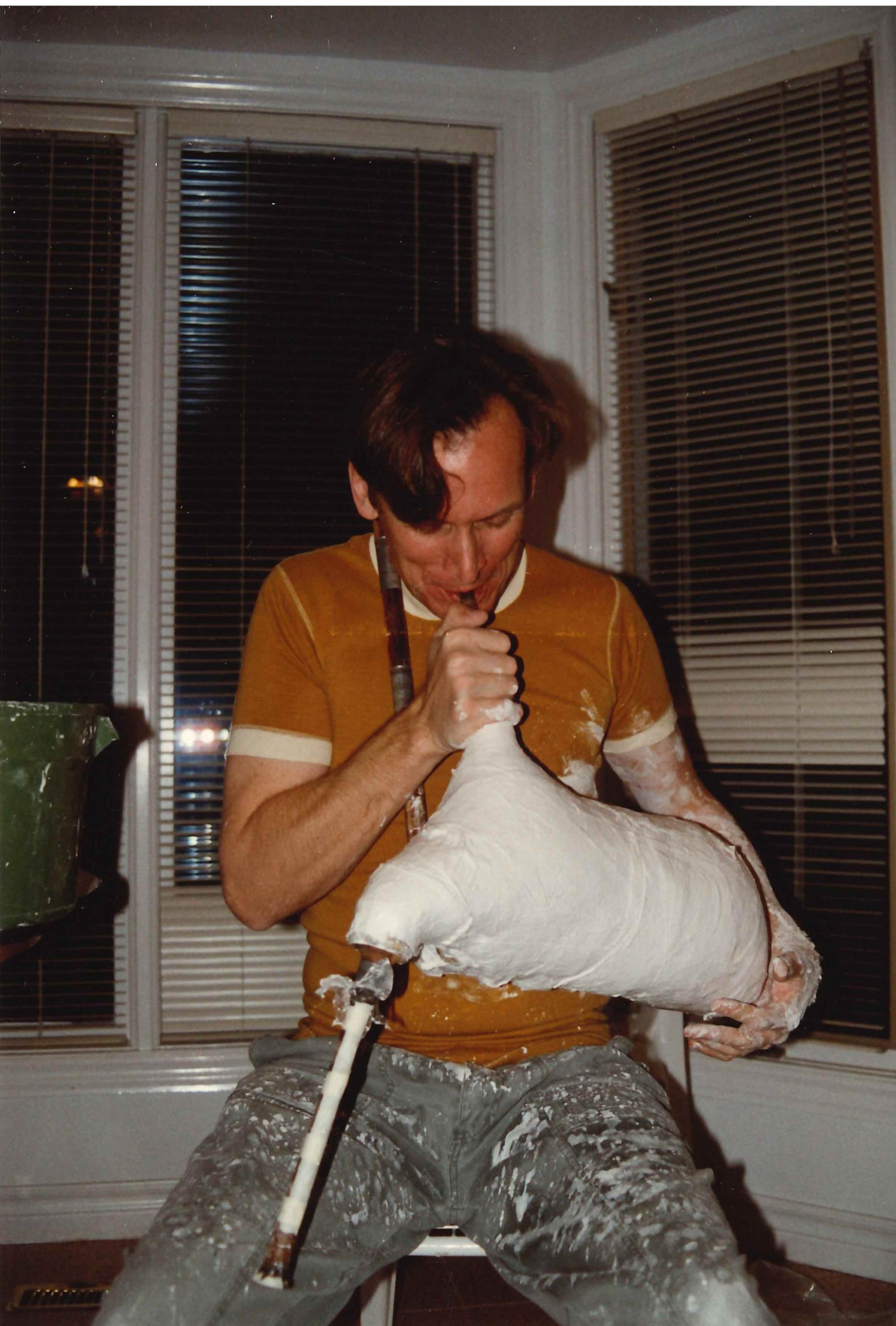Look up, look WAY up and see the “Heavenly Music” atop the music library entrance.
“Heavenly Music,” by Lutz Haufschild, was commissioned and installed on 1 April 1991 for the official opening of the Rupert Edwards Wing of the Edward Johnson Building, the new home of the music library (the unofficial opening had taken place 28 June 1990). The commission was a gift to the University of Toronto by John Beckwith, then director of the Institute for Canadian Music (now the Institute for Music in Canada), and Kathleen McMorrow, then head librarian of the Faculty of Music Library.
The installation consists of three human figures, each with a different musical instrument. McMorrow told me recently that they represent the variety of music taught in the Faculty: the Gaida (bagpipes), for non-Western music (ethnomusicologist Timothy Rice had recently organized the year-long visit of a Bulgarian master); the guitar to represent jazz/folk; and the violin for western classical.

Lutz Haufschild was then, and continues to be, an internationally recognized artist who works primarily with glass and stained glass. From the artist's website: "Haufschild is captivated by the shaping of natural light in architecture and considers light his true medium. By combining innovative fabrication methods with sensitive aesthetic treatments, he creates distinct and harmonious work.” Beginning in the summer of 1990, the donors worked with the Ontario Crafts Council to identify a suitable artist. After looking through a number of portfolios, it was Haufschild's work that stood out to McMorrow and Beckwith. Through an art consultant acting as Haufschild's agent, they invited the artist to visit the site of the new library and he “agreed to submit draft ideas for an appropriate work—a suspended three-dimensional piece in light materials such as glass, aluminum, and/or fabric” (correspondence between Beckwith and the University Art Curator, 8 August 1990).
There is a file on “Heavenly Music” in the John Beckwith fonds (OTUFM-10-H-1-086) that contains correspondence between Beckwith, the artist, and other stakeholders. Through this correspondence one can trace the University of Toronto protocol for donating an original art work:
- Approval of the Dean of Music (who was responsible for the new space)
- Approval of the University Art Curator (since the piece would become the property of the University of Toronto)
- Acceptance of the gift by the University Art Committee
By the end of October 1990 all the approvals had been granted, and a contract was drawn up between Beckwith and McMorrow and Haufschild, by way of an external art consultant.
In the correspondence between Haufschild and the donors it is clear there were at least two “show and tell” meetings where McMorrow and Beckwith could see and approve progress on the work. A letter from 14 November 1990 included a photo and description of the process of casting the bagpipe figure: “So you see, we don't only work hard but have fun with this project. It was quite funny, watching Stephen ‘play’ the ‘dudelsack’ while I was casting it (he had to smile too it was so ridiculous). I hope you get a chuckle out of this” (correspondence between Haufschild and McMorrow and Beckwith, 14 November 1990). A later, undated letter included a photograph of a child lying down on a table, the front of their body covered in plaster as the model for “the violinist.”

Most of Haufschild's work to that point was glass or stained-glass and abstract in nature, and the human forms in “Heavenly Music” might seem a departure. An interviewer noted in 1990, however, that “quite a bit of your new work includes figurative elements.” “Refugee Window” (1989), installed in St. Andrew's Lutheran Church in Toronto, combines geometric shapes of glass with landscape and human faces. “Tribute to Baseball” (1989) was installed in Toronto's Skydome stadium's east and west entrances and depicts baseball players in various poses. Haufschild responded, “I felt there were certain themes which I wanted to tackle which required the use of figurative elements. How do you show the suffering and hopelessness of people deported to Siberia as in the Refugee Window without showing faces that are anxious and sad? How else but by actually showing those faces?” (Hoover, p. 200).
Regrettably the violinist figure fell and cracked in 2011. When the quote from the University's Art Department for the repair proved more than the original cost of the artwork, the donors engaged a team from the Faculty's opera set design department to handle the repairs.
To read more about the artist and see images of the works described above:
Elford, Clifford. "Light and Order." Ontario Craft summer 5 (1990): 10-15.
Hoover, Richard L. "The Quintessential Lutz Haufschild." Stained Glass Quarterly 85, no. 3 (1990): 194-200. Available online to the U of T Community.
To read more about the opening of the Music Library in 1990:
McMorrow, K. “Communications.” CAML Review/Revue De l’ACBM, 19, no. 1 (1990). Available free online.